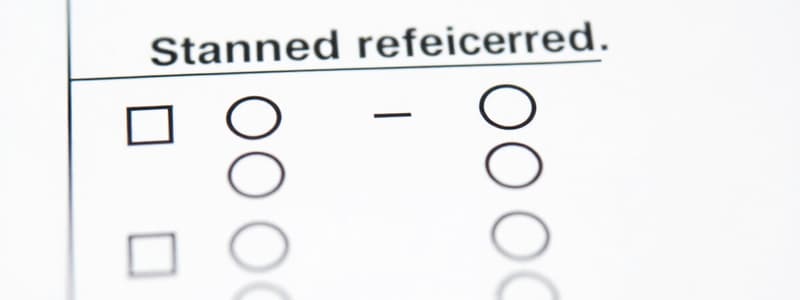Podcast
Questions and Answers
What does the Standard Error of Measurement (SEM) estimate?
What does the Standard Error of Measurement (SEM) estimate?
- The average score of a sample group
- The significance of a difference between two scores
- The relationship between two variables in regression
- The true score deviation from an observed score (correct)
What function do test score interpreters serve?
What function do test score interpreters serve?
- Provide feedback to the test developers
- Interpret test results for consumers (correct)
- Conduct the tests in a controlled environment
- Collect data from the test takers
Which of the following is true about Standard Error of the Mean (SEM)?
Which of the following is true about Standard Error of the Mean (SEM)?
- It evaluates the error associated with sample means (correct)
- It compares individual scores with normative data
- It measures the potential error in predicting variable relationships
- It determines statistical significance of score differences
In what context are behavioral observations primarily conducted?
In what context are behavioral observations primarily conducted?
What is the main purpose of a norm-referenced test?
What is the main purpose of a norm-referenced test?
Which of the following accurately describes a case study or case history?
Which of the following accurately describes a case study or case history?
What type of norm is based on characteristics related to a specific trait or ability?
What type of norm is based on characteristics related to a specific trait or ability?
What is the primary purpose of role-play tests?
What is the primary purpose of role-play tests?
How is the Standard Error of Estimate (SEE) used in regression analysis?
How is the Standard Error of Estimate (SEE) used in regression analysis?
Who typically contracts test developers for various assessment services?
Who typically contracts test developers for various assessment services?
What does the Standard Error of the Difference (SED) help determine?
What does the Standard Error of the Difference (SED) help determine?
Which of the following correctly describes a criterion-referenced test?
Which of the following correctly describes a criterion-referenced test?
What is the role of test scorers in the assessment process?
What is the role of test scorers in the assessment process?
In which setting are diagnostic tests primarily used?
In which setting are diagnostic tests primarily used?
What is 'tracking' in the context of norm-referenced testing?
What is 'tracking' in the context of norm-referenced testing?
What is the primary advantage of case history data in therapeutic interventions?
What is the primary advantage of case history data in therapeutic interventions?
What was the primary purpose of the test published by Alfred Binet and his colleague in 1905?
What was the primary purpose of the test published by Alfred Binet and his colleague in 1905?
What does 'rapport' refer to in the context of psychological testing?
What does 'rapport' refer to in the context of psychological testing?
During which major world event did the military first implement psychological tests to screen recruits?
During which major world event did the military first implement psychological tests to screen recruits?
How did psychological testing and assessment evolve after World War II?
How did psychological testing and assessment evolve after World War II?
Who was Francis Galton and what was his relation to Charles Darwin?
Who was Francis Galton and what was his relation to Charles Darwin?
What is 'accommodation' in the context of psychological assessments?
What is 'accommodation' in the context of psychological assessments?
Which of the following statements is true about individual differences according to the provided content?
Which of the following statements is true about individual differences according to the provided content?
What is 'alternate assessment' in psychological testing?
What is 'alternate assessment' in psychological testing?
What term refers to the component of a test score that occurs due to sources other than the trait being measured?
What term refers to the component of a test score that occurs due to sources other than the trait being measured?
Which assumption is related to the idea that psychological traits and states must be measurable?
Which assumption is related to the idea that psychological traits and states must be measurable?
What is the classical test theory's main assumption about individual test scores?
What is the classical test theory's main assumption about individual test scores?
Which assumption emphasizes that testing and assessment can be conducted fairly and without bias?
Which assumption emphasizes that testing and assessment can be conducted fairly and without bias?
What does the term 'trait' refer to in psychological testing?
What does the term 'trait' refer to in psychological testing?
What might be a consequence of not defining traits and states accurately in testing?
What might be a consequence of not defining traits and states accurately in testing?
Which assumption suggests that testing and assessment benefit society?
Which assumption suggests that testing and assessment benefit society?
Which aspect poses a potential fairness-related problem in testing?
Which aspect poses a potential fairness-related problem in testing?
What does the term 'criterion' refer to in the context of predictive validity?
What does the term 'criterion' refer to in the context of predictive validity?
Which of the following best defines 'hit rate'?
Which of the following best defines 'hit rate'?
What does 'miss rate' indicate in a predictive validity context?
What does 'miss rate' indicate in a predictive validity context?
What characteristic must a criterion possess to be deemed relevant?
What characteristic must a criterion possess to be deemed relevant?
In predictive validity, what does it mean for a criterion to be valid?
In predictive validity, what does it mean for a criterion to be valid?
Which term refers to an error made when a test predicts a trait that is not actually present?
Which term refers to an error made when a test predicts a trait that is not actually present?
What does 'base rate' refer to in predictive validity?
What does 'base rate' refer to in predictive validity?
If a test is used to predict marital success, which statement reflects an aspect of this prediction?
If a test is used to predict marital success, which statement reflects an aspect of this prediction?
Flashcards are hidden until you start studying
Study Notes
Types of Standard Error
- Standard Error of Measurement (SEM): Used to estimate how much an observed score differs from a true score.
- Standard Error of Estimate (SEE): In regression, it gauges the error in predicting the value of one variable from another.
- Standard Error of the Mean (SEM): Quantifies sampling error.
- Standard Error of the Difference (SED): Indicates how large the difference between two scores needs to be to be statistically significant.
Evaluation of Norms
- Norm-Referenced Test: Interpret a score by comparing it to scores obtained by others on the same test.
- Criterion-Referenced Test: Interprets a score based on performance against a specified content domain rather than a specific population. Also known as content-referenced or domain-referenced tests.
Types of Norms-Referenced Testing
- Tracking: The tendency to maintain a similar level compared to peers over time.
- Development Norms: Based on traits, abilities, skills, and other characteristics, these norms assess progression compared to typical development.
- Case History Data: Consists of records, transcripts, and information about a person or event.
Settings Where Assessments Are Conducted
- Educational Settings: Used to identify children with special needs and administer diagnostic and achievement tests.
- Clinical Settings: Employed in screening and diagnosing behavioral problems.
A Brief History of Psychological Testing
- 20th Century, France: The origins of modern psychological testing and assessment can be traced back to this time.
- 1905: Alfred Binet and a colleague published a test to categorize Paris schoolchildren into different classes.
- 1917, World War I: The military utilized psychological testing to screen recruits for intellectual and emotional issues quickly.
- World War II: The military relied heavily on psychological tests to screen recruits.
- Post-War: Numerous tests were developed to measure a broad range of psychological variables.
Test User Qualification Levels
- Level A: Test users can administer, score, and interpret tests.
- Level B: Test users can administer and score tests but need supervision for interpretation.
- Level C: Test users can administer and score tests but require the assistance of Level A or B users for interpretation.
Proeminent Figures in the History of Psychometrics
- Charles Darwin: Argued that some individual differences are more adaptive than others, leading to more complex beings over time.
- Francis Galton: Applied Darwin's theories to study human abilities. He believed that assuming heterogeneous data is crucial for understanding differences in test performance.
Individual Differences
- Error Variance: Variations in test scores due to factors other than the measured trait or ability.
- Classical Test Theory: Assumes each test taker has a true score that would be obtained if not for measurement error.
Assumptions About Psychological Testing and Measurement
- Assumption 1: Psychological Traits and States Exist.
- Assumption 2: Psychological Traits and States Can Be Quantified and Measured.
- Assumption 3: Test Scores Are Relatively Consistent (Reliable).
- Assumption 4: Tests Actually Measure What They Claim to Measure (Validity).
- Assumption 5: Tests Can Be Used to Predict Future Performance.
- Assumption 6: Testing and Assessment Can Be Conducted Fairly and Unbiasedly.
- Assumption 7: Testing and Assessment Benefit Society.
Considerations in Predictive Validity
- Base Rate: The frequency or prevalence of a specific trait, behavior, or attribute within a population.
- Hit Rate: The accuracy of a test in identifying individuals who possess a particular trait or characteristic.
- Miss Rate: The proportion of individuals the test fails to correctly identify as having or not having a specific trait or characteristic.
- False Positive: A misclassification where a test predicts that a person has the attribute being measured when they do not.
- **
Studying That Suits You
Use AI to generate personalized quizzes and flashcards to suit your learning preferences.




